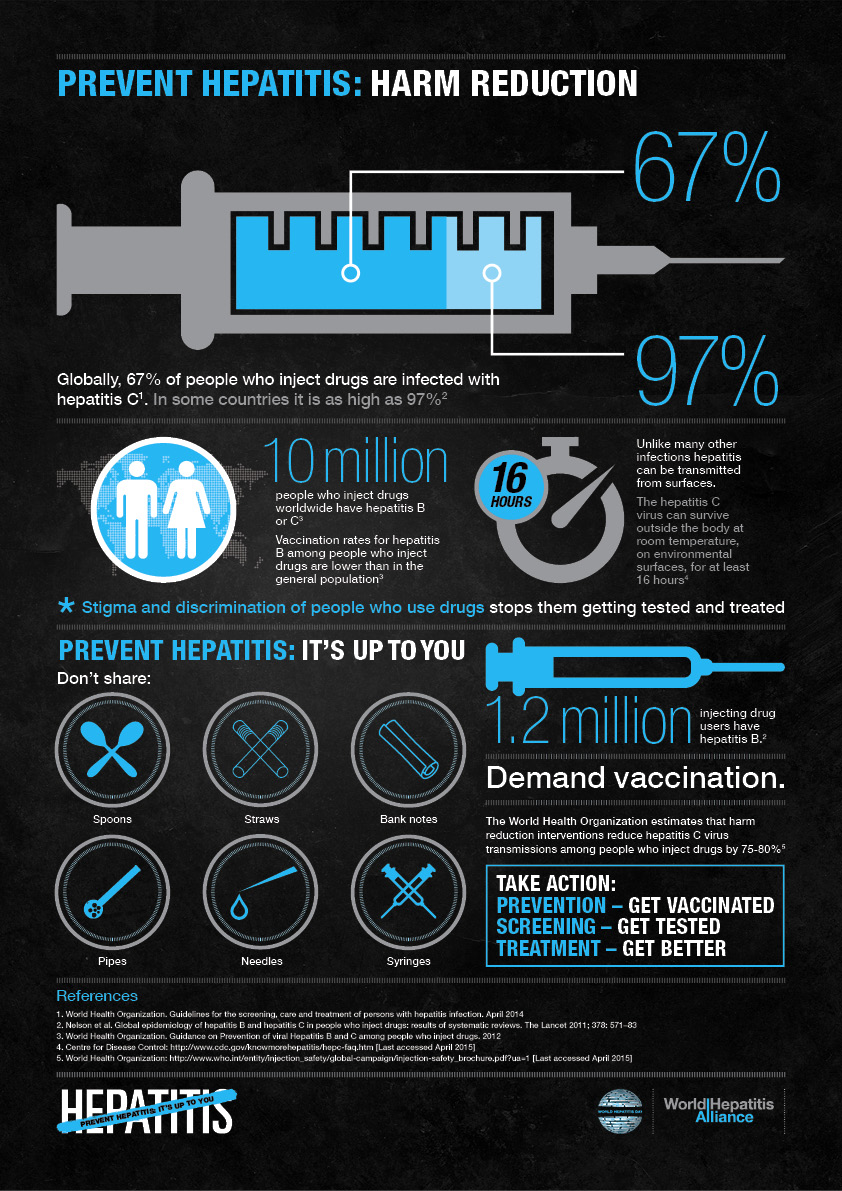This week’s infographic, created by World Hepatitis Day, takes a look at using harm reduction as a tool to reduce the spread of hepatitis. Hepatitis is a disease characterized by the presence of inflammatory cells in the liver. While it is possible for hepatitis to occur with limited, and even no symptoms, hepatitis often leads to other diseases (ex: jaundice). The term harm reduction can be defined as “an approach or strategy aimed at reducing the risks and harmful effects associated with substance abuse and addictive behaviours for the individual, the community and society as a whole.”
The infographic states that globally 67% of people who inject drugs are infected with hepatitis. Upwards of 10 million people who inject drugs worldwide have hepatitis B or C. Vaccination rates of hepatitis B among people who inject drugs are lower than in the general population. The infographic also states that stigma and discrimination of people who use drugs stop them from getting tested and treated. Individuals and families that are living in homelessness are a perfect example of individuals who face stigma and discrimination in how health services are both structured and delivered.
In Toronto, homeless individuals are 29 times more likely to have the hepatitis C virus compared to members of the general population. Over the long-term, hepatitis C can lead to long-term kidney failure and kidney cancer. Hepatitis C is primarily spread through intravenous drug use and the sharing of needles. Other homeless populations across Canada are also likely to have higher rates of hepatitis B and C compared to the general population.
Harm Reduction
Rather than condemning substance use, a harm reduction approach is focused on reducing the risks associated with using drugs. The approach is nonjudgmental, and is meant to “meet people where they are at”. Programs built into such an approach may include the facilitation of peer support groups for drug users, needle distribution as well as supervised injection sites.
Insite, located in the Downtown Eastside neighbourhood of Vancouver and the only legalized supervised drug injection site in North America, is an example of a program that takes such an approach. The neighbourhood has been considered the centre of an injection drug epidemic, and was reported to be home to 4700 injection drug users in 2000. The results of the Insite program, which opened in 2003, have been largely positive. There have been zero overdose death reported at the facility, a 78% decrease in new reported cases of HIV among people who inject drugs in the local area between 2002-2011 and a 55% decrease in new reported cases of Hepatitis C over the same time period.
There is a great deal of evidence that speaks to the effectiveness of harm reduction, both nationally and internationally. Programs and communities in Canada have been successful in reducing health risks (ex: reducing rate of infection for Hepatitis) for community members through the adoption of a harm reduction approach. However, we continue to allow misunderstandings about this innovative strategy, and misplaced fear and prejudice against drug users, to act as a barrier against wider adoption of harm reduction.


